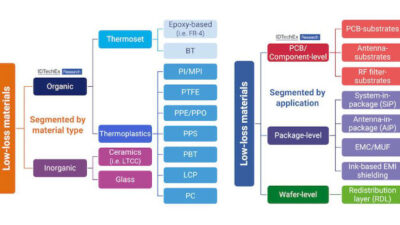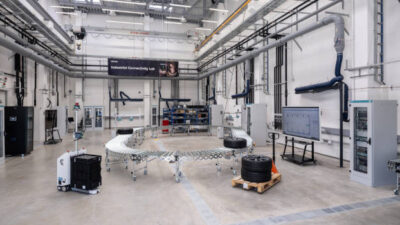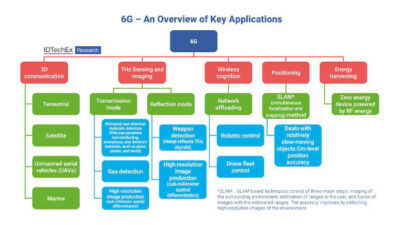Reports of the demise of the IEEE 1451 Smart Transducer Interface Standard have been greatly exaggerated—to paraphrase Mark Twain. Though not actually ailing, the standard was delayed in limbo, until developers began using its recently approved IEEE 1451.4 section. This part of the standard adds a memory component to smarten sensors, and adds self-identification using transducer electroni...
AT A GLANCE
Networks and communications
Plug-and-play analog-to-digital
1451.4’s revival
TEDS’ data enable accuracy
Sidebars: IEEE P1451 standard parts
Reports of the demise of the IEEE 1451 Smart Transducer Interface Standard have been greatly exaggerated—to paraphrase Mark Twain. Though not actually ailing, the standard was delayed in limbo, until developers began using its recently approved IEEE 1451.4 section. This part of the standard adds a memory component to smarten sensors, and adds self-identification using transducer electronic data sheets (TEDS). This simpler approach allows TEDS to be applied to countless existing analog sensor interfaces; adds plug-and-play value to them; and enables more accurate and economical solutions and applications. In short, P1451 is no longer ‘a solution looking for a problem.’ (P stands for the overall standard’s proposed status.)
This fulfills some longstanding hopes of small- and medium-sized sensor and transducer manufacturers, who simply wanted a common sensor interface, but were historically burdened by differing networks, fieldbuses, protocols, and requirements. The initial concept for the 1451 standard was to have a transducer shell with room for a driver, allowing the transducer to plug into a generic P1451 driver, alleviating the need for a specific driver, and reportedly saving 90-95% of the time previously needed to develop software.
Some history
Originally launched in 1994 by the Institute of Electric and Electronics Engineers’ (IEEE) Instrumentation and Measurement Society and the National Institute of Standards and Technology (NIST) to solve traditional sensor integration problems using standard communication interfaces, P1451 has grown to include seven working groups and active sections, four of which are formally approved (see sidebar for an update on all seven sections).
More recently, the P1451.3 working group defined the standard for applications with a cluster of sensors, and for securing high-speed, synchronized data. Meanwhile, the P1451.4 group handled applications with mixed-mode communications for analog transducers, such as digital TEDS and analog signaling.
About two years ago, National Instruments (NI) reports that it recognized 1451.4’s potential benefits, and started working more actively with its IEEE working group. NI’s encouragement and IEEE’s approval began reviving 1451.4’s momentum.
1451.4 takes off
By adding plug-and-play capability to analog transducers in networks used by digital instruments and measurement systems, IEEE 1451.4 now has a better chance of accelerating adoption of networked sensors by simplifying transducer installation, network creation, and system maintenance and upgrade. 1451.4 does this by creating a universal system that information digital networks need to identify, characterize, interface with, and use signals from analog sensors.
Watlow and National Instruments report that smart thermocouples can now be more accurate than resistance thermal devices (RTDs) at most temperatures, and that smart RTDs can achieve reference accuracy.
David Potter, vice chair of 1451.4’s working group and NI’s platform manager, explains that 1451.4 is a practical standard that makes TEDS compatible with analog measurement. ‘By adding self-identification at the transducer analog interface, this standard has the potential to make any measurement system, analog or digital, easier to set up, configure, and maintain. When a sensor is connected to a data acquisition device or any instrument board, there’s a lot of setting up of ranges, filters, and other parameters. If this information is already stored in a memory chip, then you can do set up and calibration automatically.’
1451.4 also uses electrically erasable, programmable, read-only memory (EEPROM) chips embedded in sensors to house and communicate details for plug-and-play capability. Manufacturers can obtain identifiers for chips from the Internet. A complete TEDS may contain sections for identification and properties for a specific type of sensor, such as an accelerometer, microphone, strain gage, thermocouple, thermistor, and many others. TEDS may also contain complete calibration data for the sensor.
For special sensor requirements, template description files can be written and published on a Web site. The standard also allows for virtual TEDS files that reside on the Internet for use when embedded memory, such as EEPROM, is unavailable, usually in legacy sensors. NI and its partners maintain a large library of virtual TEDS, which can be downloaded free of charge at www.ni.com/sensors . About 25 companies are presently making 1451.4-enabled sensors as part of NI’s partnership program.
Watlow’s coat hanger
One way in which 1451.4 aids test and measurement users is by greatly increasing thermocouple accuracy. For instance, J-type thermocouples typically include two metal types of differing grades and relative accuracies, but Watlow Electric Manufacturing recently found that adding 1451.4’s one-wire memory device to its thermocouple increased its individual calibration and linearization curve, and decreased its measurable error three times from 1.5 °C to 0.5 °C, making it more accurate than an ANSI thermocouple.
For example, a typical Type K thermocouple may usually operate at 600 °C withsually has ±1.4 °C uncertainty, and 1451.4 can turn it into a smart RTD that can achieve 0.2 °C uncertainty, he adds.
Murphy demonstrated at ISA Expo 2004 how Watlow’s Infosense-P plug-and-play thermocouple, RTD, and thermistors can be used with a 1451.4-enabled chip and TEDS to calibrate a typical coat hanger, and make it more accurate than a traditional temperature sensor.
‘We mostly manufacture to OEMs that demand accuracy and repeatability, and they previously had to buy sensors with a tolerance window of 0.5-1.0% accuracy. Now, we can include all our calibration information in a memory device, and get back get exact digital calibration files,’ says Seymour. ‘We’re no longer limited by the snapshot from a tolerance band. We now know what a variable sensor is doing in real time because its digital component tells us what the analog side is doing. In one case, we have an OEM that’s now able to make thermocouples that are more accurate at higher temperatures than RTD sensing technology, which is also more costly.’
Seymour adds that using 1451.4-enabled chips means that Watlow also can use new material combinations, such as high-temperature alloys, in its thermocouples for even better accuracy, improved longevity, and less drift. Now, the chip has all the voltage/resistance tables, and it tells the instrumentation what type of sensor it’s supposed to be. ‘Users previously had to buy calibration sheets that might get lost or separated. Now, you have TEDS, and you can’t separate the information from the chip,’ adds Seymour. ‘Also, the original standard was that sensors had to perform linearly. Changes had to be linear, and so all instruments were analog. Now, we have digital electronics, and we can track any function we want, including gathering data about how sensors may fail in the future.’
For related products, visit www.controleng.com/buyersguide; for system integrators, go to www.controleng.com/integrators; or visit:
www.sensotec.com
www.ieee.org
www.go-intech.com
www.ni.com National Instruments
www.watlow.com
Online extra
Sections of IEEE P1451 Standard for a Smart Transducer Interface for Sensors and Actuators
P1451.0 What: Common functions, communications protocols, and Transducer Electronic Data Sheet (TEDS) formats Function: Project aims to develop a set of common functionality, commands, and TEDS for the IEEE 1451 family of smart transducer standards. This functionality will be independent of the physical communications media. It includes basic functions required to control and manage smart transducers, communications protocols equivalent to layers 3 though 7 of the International Standards Organization’s (ISO) Open Systems Interconnection (OSI) model, and media-independent TEDS format. It will define a set of implementation-independent application programming interface (API) as needed. Status: Proposal in development; balloting expected in 2005
1451.1 What: Network-Capable Application Processor (NCAP) information model. Function: Defines the common object model for smart transducers, and tries to find the interface specifications to the components of that model. Proactively defining their behavior helps make devices network neutral and easier to configure. Status : Approved as a standard, June 1999; presently being revised.
1451.2 What: Transducer-to-microprocessor communications protocols and TEDS formats. Function: Defines interface standard for analog-to-digital communications Status: Approved as a standard, September 1997; being revised to include UART interface.
1451.3 What: Digital Communication and TEDS formats for distributed multidrop systems Function: Uses 1451.2 as baseline for developing TEDS for distributed multidrop network systems that use higher bandwidth data. Status: Approved as a standard, November 2003.
1451.4 What: Mixed-mode communication protocols and TEDS formats Function: Defines mixed-mode communications that use reversed polarity to allow digital transmission of TEDS data, and then sending an analog transducer signal over the same two wires. Status: Approved as a standard, May 2004; expected to publish November 2004.
P1451.5 What: Wireless communication and TEDS formats Function: Trying to reduce cabling and installation costs; decrease cable/LAN drops; improve data collection with easier, affordable condition-based monitoring; and aid savings with predictive maintenance. P1451.5’s physical layers may include IEEE 802.11b (WiFi), 802.11g (ZigBee), 802.15 (Bluetooth), 802.15.4 (PAN), and others. Status: Proposal in development; balloting expected in 2005
P1451.6 What: High-speed CANopen-based transducer network interface for intrinsically safe and non-intrinsically safe applications. Function: This project plans to allow development of lean gateways and cascaded transducer networks based on a combining the IEEE P1451 and CANopen specifications, and create a sensor interface for CANopen-based networks that incorporates P1451’s TEDS concept for intrinsically safe and non-intrinsically applications. This would allow sensor bus and transducer network users in instrumentation, measurement, and process industries on CANopen networks to use 1451 transducers and benefit from TEDS. Status: Proposal in development
IEEE P1451 standard parts
P1451.0—Common functions, communications protocols, and Transducer Electronic Data Sheet (TEDS) formats.Function: Draft standard aims to develop a set of common functionality, commands, and TEDS for the IEEE 1451 smart transducer standards.Status: Draft standard in development; balloting expected in 2005.
1451.1—Network-Capable Application Processor (NCAP) information model.Status: Approved as a standard, June 1999; presently being revised.
1451.2—Transducer-to-microprocessor communications protocols and TEDS formats.Status: Approved as a standard, September 1997; being revised to include UART interface.
1451.3—Digital communication and TEDS formats for distributed multidrop systemsStatus: Approved as a standard, November 2003.
1451.4—Mixed-mode communication protocols and TEDS formatsFunction: Defines mixed-mode communications that use reversed polarity to allow digital transmission of TEDS data, and then sending an analog transducer signal over the same two wires.Status: Approved as a standard, May 2004; expected to publish November 2004.P1451.5—Wireless sensor communication and TEDS formatsFunction: Reduce cabling and installation costs; decrease cable/LAN drops; improve data collection with condition-based monitoring; and aid predictive maintenance.Status: Draft standard in development; balloting expected in 2005.
P1451.6—High-speed CANopen-based transducer network interface for intrinsically safe and non-intrinsically safe applications.Status: Draft Standard in development.



